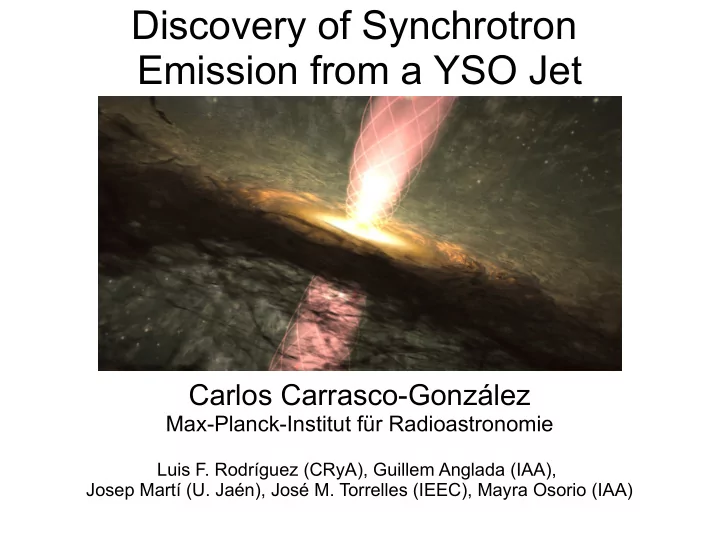

Discovery of Synchrotron Emission from a YSO Jet Carlos Carrasco-González Max-Planck-Institut für Radioastronomie Luis F. Rodríguez (CRyA), Guillem Anglada (IAA), Josep Martí (U. Jaén), José M. Torrelles (IEEC), Mayra Osorio (IAA)
Jet Formation and collimation Fundamental ingredients → Accretion disk + Magnetic field Rotation + acretion → B is twisted in the disk Large distances → helical B → confines the material Similar mechanism for all kind of jets: - AGNs - Microquasars - PNe - YSOs - …
YSO Jets Fantastic targets because of number, nearby and lot of information can be obtained from observations Optical & IR → Temperature, density, mass Radio → ionized gas, base of the jet mm/submm → Disk, outflow But magnetic field difficult to “observe”
Magnetic Fields in YSO Jets Dust Polarization Cloud's Magnetic Field Girart et al. (2006) Launching region Maser Polarization Vlemmings et al. (2010)
Synchrotron Emission from relativistic jets Magnetic fields in relativistic jets can be “easily” studied through their synchrotron emission at radio wavelengths Intensity of radio emission → Intensity of B Linear Polarization → Direction of B Pol. Deg and Faraday Rotation → 3D structure of B
Synchrotron Emission in YSO Jets??? IRAS 16547-4247 SERPENS HH 80-81 Rodriguez et al. (1989) Marti et al. (1993) Cep A W3 (H2O) Rodriguez et al. (2005) Wilner et al. (1999) Garay et al. (1996)
HH 80-81 Distance: 1.7 kpc IRAS 18162–2048 ; 17,000 L (B0; 10 M ) HH 80, HH 81, HH 80 N (Martí et al. 1993) Largest (~5.3 pc) and most collimated (<1º) YSO radio jet known
HH 80-81 SMA & VLA Observations Radius ~ 200 AU Disk Mass ~ 4-7 Msun Accretion rate ~ 10 -4 Msun/yr U A U 0 A 0 7 0 0 0 5 Carrasco-González et al., in prep.
HH 80-81 Martí et al. (1993) Central source: Thermal free-free emission and dust from the disk HHs and knots in the radio jet: non-thermal Which is the emission mechanism? If synchrotron → magnetic field + relativistic electrons electron acceleration → strong shocks (Fermi mechanism) POSSIBILITY TO STUDY THE MAGNETIC FIELD IN THE JET THROUGH LINEAR POLARIZATION!!! ...but weak → very high sensitivity required So, we observed with the VLA at 6 cm during 12 hours We reached a rms noise of ~ 10 microJy/beam
Magnetic field appears parallel to the jet axis We estimate magnetic field strength 0.2 mG Carrasco-González et al. (2010)
Polarized dust emission direction shows considerable scatter with respect to the jet direction (Curran et al. 2007) → envelope/disk Magnetic field traced by synchrotron emission is intrinsic to the jet We measure similar values for the magnetic field strength at 0.5 pc from the star The jet is removing magnetic field from the disk
Polarization degree increases towards the edges of the jet Similar to what is commonly found in extragalactic jets and what we would expect to observe in a helical magnetic field (e.g. Lyutikov et al. 2005) Gómez et al. (2008)
Compatible with helical magnetic field. But need of Farady Rotation measurements.
Expanded Very Large Array ALMA Higher Sensitivity High angular resolution and sensitivity at (sub)mm wavelengths 100 000 AU Observations of a sample of protostellar jets Disk's magnetic field Using this technique and combining with others (optical/IR) we can obtain full description of jets
Recommend
More recommend